In September, a team of scientists reported finding phosphine in the upper atmosphere of Venus. Phosphine can be a biomarker and is here on Earth. But it's also present on Jupiter, where it's produced abiotically. The discovery led to conjecture about what kind of life might survive in Venus' atmosphere, continually producing the easily-degraded phosphine.
The authors of that study were circumspect about their own results, saying that they hope someone can determine a source for the phosphine, other than life.
Now a new study says that the original phosphine detection is not statistically significant.
The new study is a re-production and re-evaluation of the original ALMA (Atacama Large Millimeter/sub-millimeter Array) data that the initial detection of phosphine was based on. It comes from a team of five researchers from the Netherlands.
The title of the study is " Re-analysis of the 267-GHz ALMA observations of Venus: No statistically significant detection of phosphine." The lead author is Ignas Snellen, Professor of Astronomy at Leiden University in the Netherlands. The paper has not been peer-reviewed yet and is available on the pre-press site arxiv.org.
After the initial discovery of phosphine at Venus, reported here at Universe Today, other scientists took notice. Other studies followed up on that work. One attempted to calculate how much life would be needed to produce the detected phosphine. Another suggested that life isn't necessary, and volcanoes could produce it.
But now it looks like the phosphine might not even be there at all.
The detection of the phosphine depended on a single 267 GHz spectroscopic line in the ALMA observations. It revealed a 20 parts per billion concentration of phosphine in Venus' upper atmosphere according to the original paper (Greaves et al. 2020). But the authors of this new study point out some problems in the initial detection.
First of all they point out that there are no evident ways for phosphine to be produced on Venus. Then they write that "The aim of this work is to assess the statistical reliability of the line detection by independent re-analysis of the ALMA data." The team used the same data and followed the same methods and used the same scripts as the original study. In fact, the authors of the original study, Greaves et al., even contacted this team to provide them with an updated ALMA data-processing script.
The new study says that the method used to fit the original ALMA spectral data in the prior study "...leads to spurious results." They go on to say that their independent analysis shows a phosphine detection feature that's "...below the common threshold for statistical significance." Then, "...we consider a feature at such level as statistically unreliable that cannot be linked to a false positive probability."
Astronomical data like the type used in these studies is subject to a [signal-to-noise ratio](https://en.wikipedia.org/wiki/Signal-to-noise_ratio#:~:text=Signal%2Dto%2Dnoise%20ratio%20(,power%2C%20often%20expressed%20in%20decibels.). It compares the level of the desirable, information-rich signal to the background noise. In order to be significant, the signal has to rise far enough above the noise. A low SNR means the data signal has not risen far enough above the noise to be significant. The ALMA data failed to do that, according to this study. The authors found SNRs of only two and one, depending on the analysis of the data and how it was fitted.
They don't hold any punches in their conclusion, saying "We find that the 267-GHz ALMA observations presented by GRB20 provide no statistical evidence for phosphine in the atmosphere of Venus."
This is exactly how science is supposed to work. For scientific results to be valid, their findings have to be recreated and validated by others. The authors of this study make sure to mention that the authors of Greaves et al. were just as interested as they were in having their results tested and that Greaves and the other researchers behind the phosphine discovery made their data and methods available to them. "We thank the authors of GRB20 for publicly sharing their calibration and imaging scripts."
Stay tuned. This may not be the last word on phosphine on Venus.
More:
- New Research (not yet peer-reviewed): Re-analysis of the 267-GHz ALMA observations of Venus: No statistically significant detection of phosphine
- Original phosphine study: Phosphine gas in the cloud decks of Venus
- Universe Today: Did Pioneer See Phosphine in the Clouds of Venus Decades Ago?
...
 Universe Today
Universe Today


